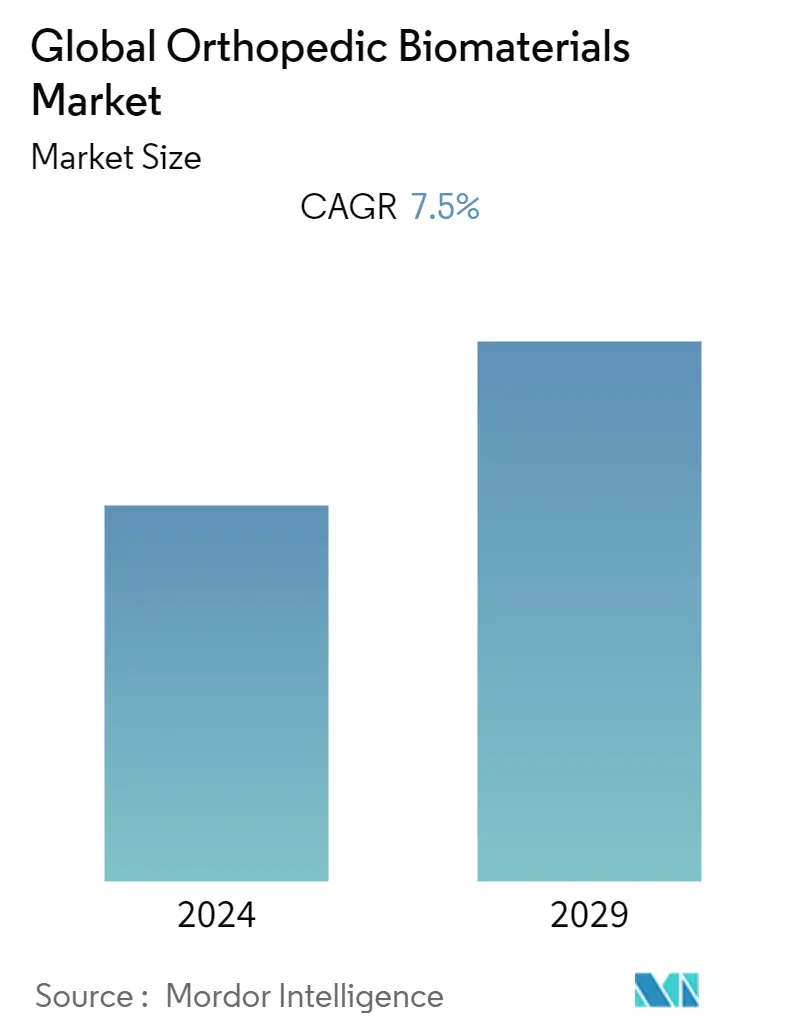Market Size of Global Orthopedic Biomaterials Industry

| Study Period | 2019 - 2029 |
| Base Year For Estimation | 2023 |
| CAGR | 7.50 % |
| Fastest Growing Market | Asia Pacific |
| Largest Market | North America |
| Market Concentration | Medium |
Major Players
*Disclaimer: Major Players sorted in no particular order |
Need a report that reflects how COVID-19 has impacted this market and its growth?
Orthopedic Biomaterials Market Analysis
The Orthopedic Biomaterials Market is expected to register a CAGR of 7.5% during the forecast period.
Due to nationwide lockdowns during the pandemic, private and public transportation was restricted, resulting in fewer road accidents and injuries. As a result, the focus of the healthcare facilities switched from surgical procedures to COVID-19 patients, which had a short-term impact on the market in the initial pandemic phase, particularly in specialized hospitals. In addition, orthopedic centers and hospitals worldwide were handling only emergency conditions as they were operating with limited resources, while other hospitals were transformed into containment facilities and treatment units for COVID-19 patients. The inevitable pausing of all elective surgeries had limited hands-on practice and exposure to several procedures. Thus, such factors greatly impacted the demand for orthopedic biomaterials during the COVID-19 pandemic globally. However, the post-COVID-19 situation will likely grow as pending procedures increase in the surgical volume.
Moreover, the rising number of sports injuries, an increasing number of trauma cases from accidents, and growing orthopedic surgeries like joint reconstruction and joint arthroplasty are also creating a massive demand for orthopedic biomaterials, thus driving the growth of the orthopedic biomaterial market.
The incidence of sports injuries has increased over the last few years, primarily due to the growing participation in sports as well as active participation in fitness activities. For instance, an article published in June 2021 by Frontiers in Sports and Active Living reported that the 1-year prevalence of a severe sports injury episode was 31%. The most common injury locations for these injuries were the knee (25%), ankle (20%), and hip/groin (15%). Also, the point prevalence of an ongoing injury episode was 19%. The most common locations were the knee (24%), ankle (24%), and foot (24%). Thus, high sports-related injury leads to increasing demand for orthopedic biomaterials, fueling the studied market's growth.
The rising geriatric population, growing incidences of musculoskeletal injuries, and rising numbers of patients opting for knee replacement, construction, and other joint-related orthopedic procedures are expected to drive market growth. According to the United Nations Department of Economic and Social Affairs, World Population Prospects 2022, the share of the global population aged 65 years or above is projected to rise from 10% in 2022 to 16% in 2050. By 2050, the number of persons aged 65 years or over worldwide is projected to be more than twice the number of children under age five and about the same as that of children under age 12. As the growing geriatric population worldwide is more susceptible to joint problems and surgeries, the adoption of orthopedic biomaterials will likely increase over the coming years. Additionally, according to the World Health Organization's update of July 2022, approximately 1.71 billion people have musculoskeletal conditions worldwide. Such a high burden of musculoskeletal conditions results in increased musculoskeletal injuries, which drives the growth of the market for orthopedic biomaterials.
Furthermore, the advancements in the field are also propelling the market's growth. For instance, in October 2021, Osfirm launched a novel implantable Whitlockite Biomaterial. Whitlockite is a form of magnesium tricalcium phosphate that has shown superior bioactive regenerative and reconstructive properties and excellent biocompatibility, making it an ideal biomaterial for implant use on sites of fracture or bone defects.
Thus, the factors above are expected to boost the market's growth throughout the analysis period. However, the lack of reimbursement policies associated with the procedures may hamper the market's growth to a certain extent.
